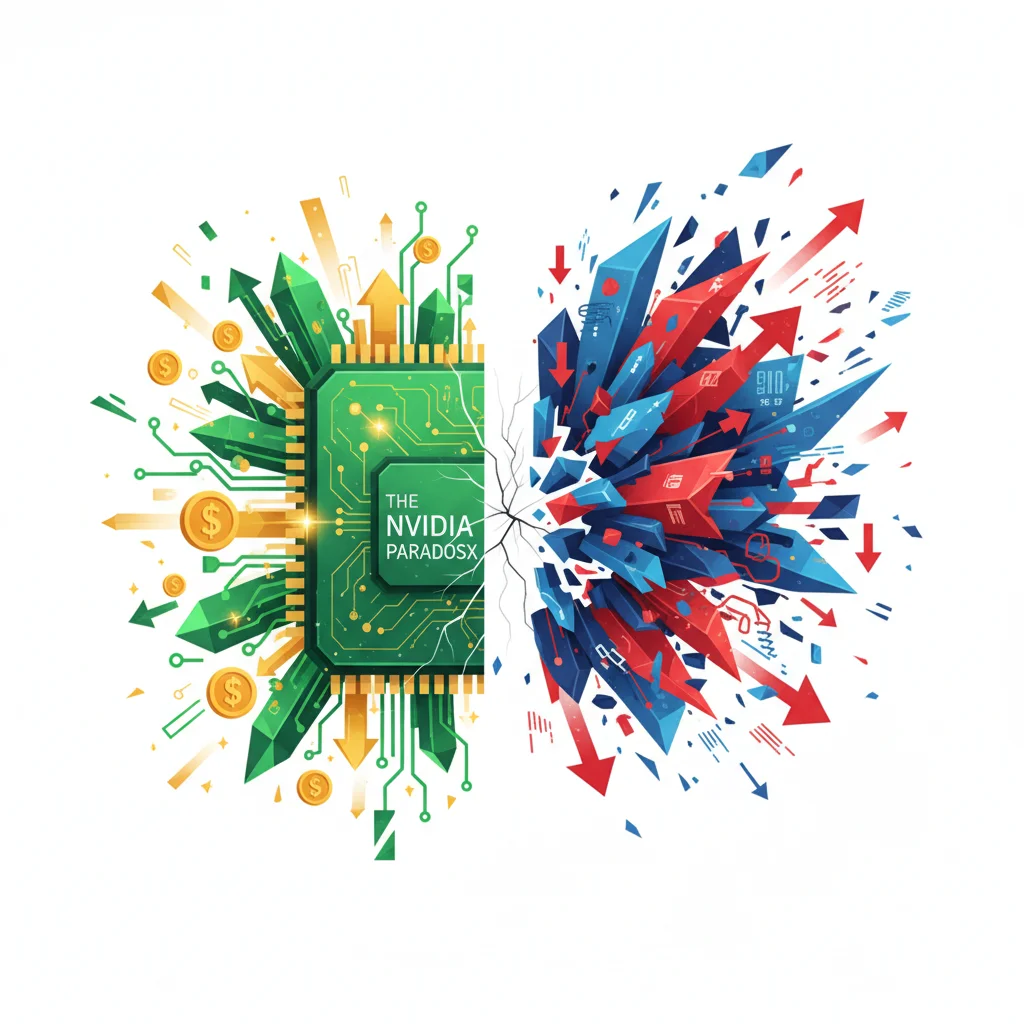
The Nvidia Paradox: Why One AI Giant’s Triumph Can’t Soothe a Nervous Wall Street
In the world of investing, a blowout earnings report from a market leader is typically cause for celebration, a catalyst that lifts the entire stock market on a wave of optimism. Yet, we find ourselves in a peculiar moment. Artificial intelligence titan Nvidia recently posted staggering sales figures, beating Wall Street expectations by a wide margin. But instead of a broad market rally, the response was a collective shrug, followed by a slide in major US indices. This disconnect, which we can call the “Nvidia Paradox,” reveals a deeper, more complex narrative about the current state of the global economy and the jitters plaguing investors.
While Nvidia’s success is a testament to the transformative power of the AI revolution, it’s acting less like a rising tide lifting all boats and more like a solitary lighthouse in a gathering storm. The market’s muted reaction is a clear signal that investors are weighing the singular triumph of one company against a formidable wall of macroeconomic worries. From persistent inflation and the specter of “higher-for-longer” interest rates to concerns about market breadth and corporate profits outside the tech bubble, the financial landscape is fraught with uncertainty. This article will dissect the Nvidia Paradox, exploring why even unprecedented success in the AI space isn’t enough to quell Wall Street’s deep-seated anxieties and what this means for the future of trading and investment strategy.
The Unstoppable Force: Deconstructing Nvidia’s AI Dominance
To understand the market’s reaction, we must first appreciate the sheer scale of Nvidia’s achievement. The company, which designs the graphics processing units (GPUs) that power virtually all advanced AI models, is not just a participant in the AI boom; it is the primary architect of its infrastructure. In its latest quarterly report, Nvidia announced revenue that soared into the tens of billions, a figure that continues to defy even the most bullish predictions. This isn’t just growth; it’s a seismic shift in the technology sector, cementing Nvidia’s position as a cornerstone of modern financial technology and innovation.
The demand for Nvidia’s H100 and new Blackwell-generation chips is insatiable, driven by tech giants like Microsoft, Google, Amazon, and Meta, all racing to build out their AI capabilities. This has created a powerful economic moat for Nvidia, with a backlog of orders that provides a clear revenue runway for the foreseeable future. According to a recent BBC report, the company’s strong sales have positioned it as one of the world’s most valuable firms, yet this has done little to quell broader investor worries. In a normal market environment, this kind of fundamental strength would be a powerful tailwind for all equities, signaling robust corporate health and a bright future for technological advancement.
Scotland's Landmark Bond Issue: A New Chapter in UK Finance or a Step Towards Independence?
The Immovable Object: A Wall of Macroeconomic Worry
However, we are not in a normal market environment. The optimism generated by Nvidia is crashing against a formidable wall of macroeconomic headwinds that are impossible for prudent investors to ignore. These concerns are the primary drivers behind the market’s recent slide.
1. The Shadow of the Federal Reserve and Interest Rates
The single most significant factor weighing on the market is the stance of the U.S. Federal Reserve. For months, investors had been pricing in multiple interest rate cuts in 2024. However, inflation has proven stickier than anticipated, forcing Fed officials to adopt a more hawkish “higher-for-longer” tone. High interest rates impact the stock market in several ways:
- Discounting Future Earnings: High-growth tech stocks are valued based on their expected future profits. Higher interest rates mean those future earnings are worth less in today’s dollars, putting downward pressure on valuations.
- Competition from Bonds: When interest rates are high, low-risk government bonds offer attractive yields. This “risk-free” return pulls capital away from the more volatile stock market, as investors can get a solid return without taking on equity risk.
- Increased Borrowing Costs: Higher rates make it more expensive for companies to borrow money to fund expansion, research, and development, potentially slowing down the overall economy.
Recent minutes from the Federal Reserve’s meetings suggest that policymakers are far from ready to declare victory over inflation, and some are even open to further hikes if necessary. This uncertainty creates a challenging environment for equities, as the cost of capital remains elevated.
2. A Narrow Market Rally: The Concentration Risk
The 2023-2024 market rally has been famously narrow. A handful of mega-cap technology stocks, often dubbed the “Magnificent Seven,” have been responsible for the lion’s share of the S&P 500’s gains. While Nvidia is a star performer, the performance of the other 493 stocks in the index has been far more lackluster. This lack of “market breadth” is a classic warning sign for market technicians and strategists. It suggests that the foundation of the rally is fragile and heavily dependent on the continued outperformance of just a few names. When the broader market is not participating, it indicates weakness in other crucial sectors of the economy, from consumer discretionary to industrial and banking.
To illustrate this divergence, consider the performance gap between the tech-heavy Nasdaq 100 and other market indices like the Russell 2000, which tracks smaller U.S. companies. The disparity highlights an economy where a few tech giants are thriving while many other businesses may be struggling with higher costs and slowing consumer demand. The table below provides a simplified look at this market divergence.
Market Performance Snapshot: A Tale of Two Markets
| Metric | AI-Leading Tech Sector (e.g., Nasdaq 100) | Broader Market (e.g., S&P 500 Equal Weight) |
|---|---|---|
| Year-to-Date Performance | Strong Double-Digit Gains | Modest Single-Digit Gains / Flat |
| Primary Driver | AI Enthusiasm, Strong Earnings from a Few Giants | Concerns over Interest Rates, Inflation, Consumer Spending |
| Valuation (Forward P/E) | Elevated (Above historical averages) | More Reasonable (Closer to historical averages) |
| Investor Sentiment | Euphoric but prone to volatility | Cautious and uncertain |
Beyond Gilts: Why Scotland's First Bond Issuance is a Game-Changer for Investors and the UK Economy
Navigating the Paradox: Strategy for the Modern Investor
So, how should investors, from seasoned finance professionals to the general public, approach this complex environment? The answer lies not in abandoning technology, but in adopting a more nuanced and diversified approach to investing.
1. Look Beyond the Obvious AI Plays
While owning the “picks and shovels” providers like Nvidia has been a winning strategy, it’s crucial to look for second-order beneficiaries of the AI revolution. Which companies are effectively using AI to cut costs, improve products, and gain market share? These might be in less glamorous sectors like logistics, healthcare, or manufacturing. The long-term value of AI will be in its application, not just its creation.
2. Re-emphasize Diversification and Quality
The narrowness of the market rally is a stark reminder of why diversification remains the most important principle in finance. Ensure your portfolio has exposure to different sectors, geographies, and asset classes. Furthermore, focus on “quality” companies—those with strong balance sheets, consistent cash flow, and durable competitive advantages. These businesses are better equipped to weather economic downturns and periods of high interest rates.
3. Understand the Role of Emerging Technologies
The current focus is on AI, but the landscape of financial technology is vast. Innovations in fintech and blockchain continue to evolve, offering new avenues for efficiency and growth. While venture funding in these areas may be impacted by the macroeconomic climate, the underlying technologies are still developing. A holistic view of technology, beyond just the AI headliners, can reveal unique opportunities. For example, the intersection of AI and decentralized finance could unlock new paradigms for trading and asset management.
UK's Economic Engine Sputters: Why a Car Production Slump is a Red Flag for the Entire Economy
Conclusion: A Market in Search of a Broader Foundation
The story of Nvidia’s phenomenal success juxtaposed with a nervous, sliding stock market is the defining narrative of our time. It underscores a critical lesson in economics: a single company’s triumph, however spectacular, cannot single-handedly power a bull market in the face of systemic economic challenges. The market’s jitters are not a dismissal of the AI revolution but rather a rational acknowledgment of the persistent risks posed by inflation, high interest rates, and an uncertain growth outlook for the majority of businesses.
For investors and business leaders, the path forward requires a dual focus. It’s essential to celebrate and participate in the incredible innovation unfolding in technology. But it is equally critical to remain grounded in the fundamentals of sound financial management, risk assessment, and diversification. The Nvidia Paradox is a call for balance—a recognition that while the future is being built by a few, its foundation must be supported by the many. Until the broader economy shows signs of robust health, the market is likely to remain on edge, watching every data point and treating even the most spectacular news with a healthy dose of caution.


